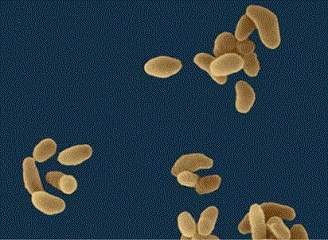Tularemia in
rabbits
Esther van
Praag, Ph.D.
MediRabbit.com is
funded solely by the generosity of donors.
Every
donation, no matter what the size, is appreciated and will aid in the continuing
research of medical care and health of rabbits.
Thank you
|
|
The bacterium Francisella
tularensis leads to the development of acute blood poisoning in hares, in
rabbits and in other animals like birds. Man can also be infected. Rabbits, hares and rodents are most
sensitive to the bacterium and the disease is fatal for them. It is suspected that the lagomorph species
are responsible for the epidemic spread of the diseases in some regions. Tularemia occurs on the American continent, in
Russia and in Scandinavia. There are nevertheless regions in Western Europe
where the bacterium is endemic such as Alsace, France. The bacterium is
spread by blood-sucking insects (lice, ticks, flies, mosquitoes) but can also
be spread by skin contact, through respiration or by contaminated food.
Francisella sp., which has been classified with the bacterial
family of Brucella sp. and Pasteurella sp., is a tiny, Gram negative, immobile and aerobic
coccobacillus. The most virulent strains are mainly observed in the USA. The disease is rarely seen in rabbits,
and contamination from a domestic rabbit to a human being has not been
described so far. Clinical
signs and diagnosis
The initial
first clinical signs include a decrease appetite, depression, ataxia (blocked
ability to coordinate movements) and a certain inclination to remain together
with other rabbits. Further characteristics of tularemia are the presence of
skin abscesses and infection of the lymphatic glands (nodular form of the
disease). In severe cases, the disease can be accompanied by pneumonia and
septicemia Since the time
between infection and the death of the rabbit is rapid, tularemia is usually
diagnozed after the death of the animal only. An autopsy shows the presence of
bleedings in the pleura and an accumulation of blood in the lungs. The liver
is enlarged and the presence of blood clots is observed in this organ as well
as in the spleen. The lymph nodes are usually swollen. This disease is very contagious
to human beings, and extra safety measure must be taken during the treatment
and the lab work. Francisella sp.
grows only on a special medium, e.g. the blood cystine medium. A further
analytical tool is the ELISA test. Treatment
As in human beings, streptomycin
or other aminoglucoside antibiotics are given to the rabbit. The advantage of
tetracycline antibiotics is that it can be administrated orally, but often,
the disease is recurrent after the treatment is halted. Further information1. Frolich K, Wisser J, Schmuser H, Fehlberg U, Neubauer H, Grunow R, Nikolaou K, Priemer J, Thiede S, Streich WJ, Speck S. Epizootiologic and ecologic investigations of European
brown hares (Lepus europaeus)
in selected populations from
Schleswig-Holstein, Germany. J Wildl Dis. 2003;
39:751-61. 2.
Garcia del
Blanco N, Gutierrez CB, de la Puente VA, Rodriguez
Ferri EF. Biochemical
characterization of Francisella tularensis strains isolated in Spain.
Vet Rec. 2004; 154:55-6. 3. Lepitzki, D.
A., A. Woolf, and M. Cooper. 1990. Serological prevalence of tularemia in
cottontail rabbits of southern Illinois. J.
Wildl. Dis. 26:279–282. 4. Morner T,
Mattsson R, Forsman M, Johansson KE, Sandstrom G. Identification and
classification of different isolates of Francisella tularensis. Zentralbl Veterinarmed B. 1993;
40:613-20. 5. Morner T. The
ecology of tularaemia. Rev Sci Tech. 1992; 11:1123-30 6. Manning, P J,
Ringer DH, Newcomer, CE, The Biology of the
Laboratory Rabbit. (1994). Academic
Press, New York, New York. |
e-mail: info@medirabbit.com




